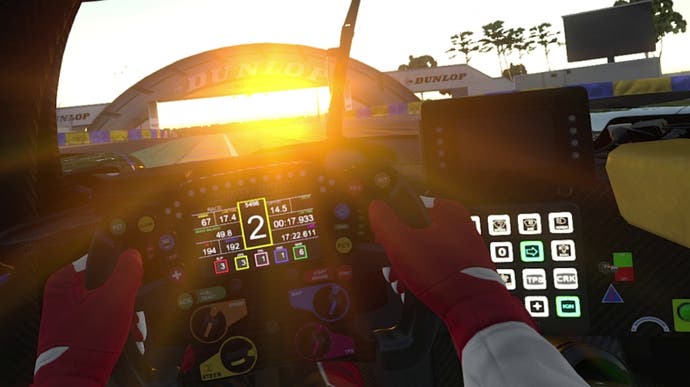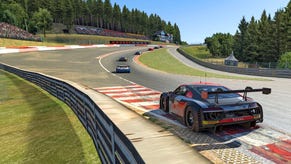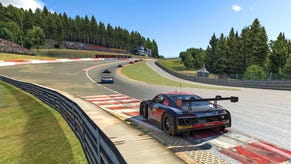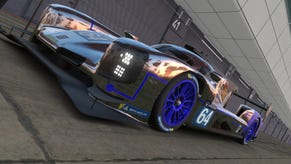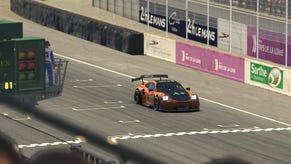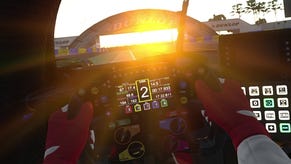Why I race
It's regarded by many as the ultimate driving sim - so what is it that makes iRacing special?
Just after the sun's risen on the second day of a 24 hour race comes what's known as happy hour. It's when the track's at its best as some warmth returns to the tarmac after the chill of the night, and when lap times begin to tumble. It's when endurance racing presents its most picturesque side, the morning light capturing the bumps and bruises upon the cars that remain, a gentle mist rising from the trackside verges. For the drivers and teams, just having survived through the night of one of motorsport's greatest challenges is reason enough for good cheer.
Ever since I fell in love with the 24 Hours of Le Mans, I've always made a point of being around for happy hour. On the years I'm lucky enough to be trackside, I'll stroll from Maison Blanche to Tetre Rouge, enjoying the strange serenity of a world slowly waking to a race that hasn't stopped, pausing to get - depending how the night before went - a fresh coffee or one final branded beaker of flat beer. Watching at home, I set an alarm so I can sprint downstairs just before dawn, where my visiting dad will be sitting on the sofa wide awake having powered through the night.
This year, though, I found myself in my shed at sunrise, lowering myself into my primitive rig and strapping on a Rift headset as I prepared myself for a stint in my first ever iRacing team endurance event. They're sim racing's equivalent of an MMO raid, where small groups share cars in a race that goes once around the clock. My team - a gaggle of friends with a few iRacing veterans amongst us happy to show rookies like me the ropes - had made it to the morning, and my team boss, knowing how sentimental I can be about such things, gave me the privilege of taking the seat for happy hour.
Happy? Try ecstatic instead. Ticking off the laps and trying to keep our Porsche 911 RSR in one piece, seeing the sun dip underneath the Dunlop Bridge and strobe through the trees that line the flat-out run from Mulsanne to Indianapolis, I got that same little tickle in the pit of my stomach that I get every June when the big race comes around. Surely, I said to myself, it doesn't get much better than this.
In many ways 2020 has been iRacing's year, its popularity boosted as racers and race fans found themselves isolated from the real thing, but the online racing service has been around since 2008. Its roots go even further back, its foundations laid in a series of genre defining games that came from a small Massachusetts studio known as Papyrus. It's where programmer David Kaemmer, inspired by his experiences with Microsoft Flight Simulator, set about applying that same approach to the humble racing game, resulting in 1989's Indianapolis 500: The Simulation - which, alongside Geoff Crammond's Revs, was one of the first commercially available driving sims.
Crammond and Kaemmer refined their art throughout the 90s, the former through his F1-focussed Grand Prix series while the latter explored more stateside-friendly takes on the sport with officially sanctioned IndyCar and NASCAR games. Papyrus' crowning moment would come with its own take on F1, though, as Grand Prix Legends sought to simulate the 1967 season in all its brutal glory in what remains a standout title. Here was a driving model with bite to match the sonorous bark of its V8s and howling V12s, its hard edges and authenticity informed by Kaemmer's own burgeoning efforts as a race driver in the Skip Barber series.
Papyrus Design Group was wound up by Vivendi in 2004, after which Kaemmer and his team set up a simulation service that went beyond just offering an exacting handling model - it set about recreating the thrill of racing wheel to wheel. iRacing's model for competitive online racing has by now become standard in the genre, and its big trick is nothing more complex than looking to the world of real motorsport as inspiration for its systems. You'll have to run around with the rookies for a while to learn some basic racecraft before you're able to earn a licence for more serious competition.
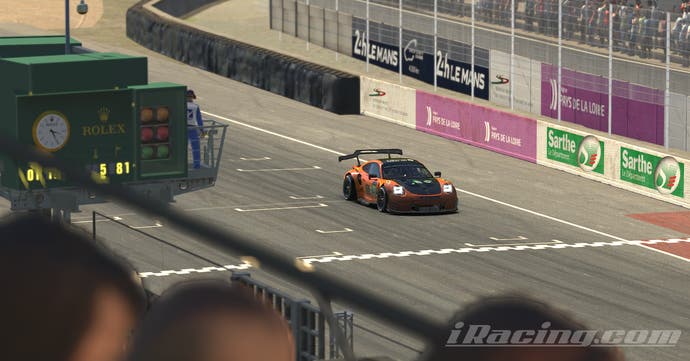
Your iRating acts as a reflection of your prowess, while your safety rating - dictated by on-track incidents and incursions - is proof of your roadworthiness. Combined, it makes for racing with a real sense of consequence, and it's one of the reasons iRacing provides some of the cleanest, fairest online competition around. It's why, when sitting on the grid in those motionless moments before a race starts, you'll be gripped by the same nerves real drivers get on a Sunday afternoon as they wait for the lights to go out.
It's also probably why you'll often find racing alongside professional drivers. When grinding out the required licence for this year's big Le Mans event, I lined up on the same grid as 2008 LMP2 winner Jeroen Bleekemolen - come the race itself, even though we found ourselves in one of the lowest splits thanks to the inexperience of most of our team, the winning car had something of a secret weapon in the shape of Alexandre Prémat, formerly part of Audi Sport Team Joest's formidable line-up. F1 drivers Max Verstappen and Lando Norris are regulars - I've run races a couple of splits behind young Max, and been heartened to see I was only four seconds a lap off the real-life alien.
From all of that you might deduce iRacing is reasonably close to the real thing, and just like the real thing it can be an almighty expensive pursuit. There's a monthly subscription that'll include all you need to get going, but soon enough you'll be needing to buy cars and tracks on top of that. Smarter people than me have figured out it'll cost you around £350 for your first full season's racing, which sounds about right, plus you'll have to factor in a half-decent PC, of course, and a racing rig of your own. I race on a modest budget with a Playseat Challenge and Fanatec CSL Elite, though after a while you'll probably want to throw a load cell brake pedal and VR kit amidst that lot... And all of a sudden you're looking at an outlay that's not too far off what a season's karting cost back when I used to race for real.

iRacing is still a whole lot cheaper, though, and a lot more convenient than dragging a race car from circuit to circuit on the back of a trailer. Which is why, alongside the real racing drivers, you'll find a whole lot of wannabes too. In my small team alone there's someone who races late model NASCARs, another with a season of Ginetta racing under his belt while our number one driver, mentor and mechanic Mikah has got first-hand experience of GT racing stateside. I'd say we're failed racing drivers, but that's being a touch grandiose about it all - rather we're just extreme racing enthusiasts, united by our passion for the sport.
The world of motorsport is represented well in iRacing, not just in the spirit of its competition but also in the breadth of what it offers. There's oval racing, rallycross, dirt racing, classics such as the Lotus 49 and 79 through to the Kamel GT series that throws together the Nissan GTP ZX-T and Audi 90 GTO for one gloriously loud late-80s mess. The tracklist is ample, and if your wallet is deep enough you'll be able to sample backwaters like Stafford Motor Speedway through to the infamous bumps of Sebring. There's decent European offerings, too, with laser-scanned takes on old faithfuls like Spa Francorchamps, Le Mans and all 15.7 miles of the Nürburgring.
Not all content is equal, mind - or, at least, some parts of iRacing aren't as advanced as others. As you might expect of a service that's been running for well over a decade, there's a patchiness to it all - some cars have the newest handling and damage model, some do not, a fair few of the laser scanned tracks are beginning to show their age and it's all held together by a UI that's only recently approached any kind of functionality. The handling won't be to everyone's taste, even if its edge of adhesion isn't as harshly defined as it once was. There's now a more pliable nature to iRacing's once unforgiving model, the ice rinks of old thawing to something much more enjoyable.
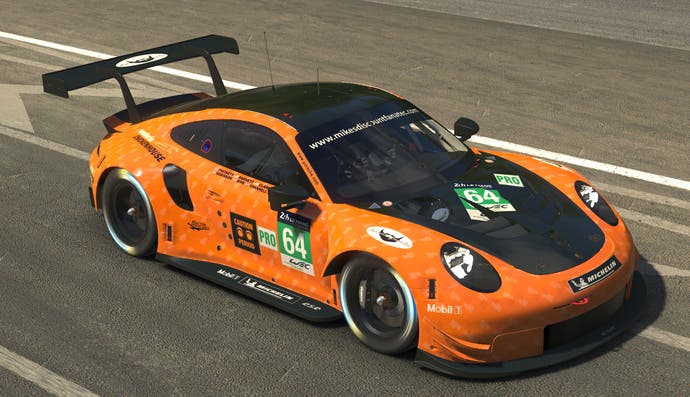
Find a combination that works, though, and this thing flies. A recent addition has been Dallara's P217 LMP2 car, the little rocketship that can be found competing in IMSA and WEC, and it is a blast. Light and eminently chuckable - with a brilliantly throaty rasp when you push it sideways and the traction control kicks in as it attempts to keep you alive - it's also got a nice line in primitive V8 power. I lost entire evenings around the soaring rises and blind dives of Road Atlanta while preparing for this month's Petit Le Mans, the P217's rear tires hopping from one kerb to another like it was my old 100cc kart.
The P217 is at the heart of team endurance racing, which is doubtless iRacing's strongest suit. To explain what makes these events so special, it's perhaps best to start with what makes the endurance discipline so attractive in the first place. First there's the simple romance of spending 24 hours in one spot and seeing the day unfurl, watching the sun set and then rise again and witnessing all the dramas in between.
All the while the challenge you face changes with each passing minute. Isn't it boring racing the same lap again and again for an entire day, you might ask. The answer is there's little as rewarding, because no two laps around Le Mans are ever the same. Track temperature and conditions are key here, the circuit rubbering in as it reaches its optimum state, while varying fuel loads and the changing state of your own tires ensures you're always on your toes. And that's before we've started to talk about the traffic.
The genius of endurance racing - or should that be the madness of it - is that it's multi-class. At Le Mans, for example, you have the LMP1s, science fiction spaceships with their hybrid technologies, followed by our perfectly formed little LMP2s. Then there's the GTEs, a fiercely competitive field of recognisable Ferraris, Porsches and BMWs that like to spend all race running door handle to door handle. At a track like Le Mans you're looking at a 40 second differential between the top class and the bottom over a single lap, which means traffic, and lots of it.
If you've ever found F1 lacking, imagine they sent the F2 and F3 cars out at the same time and what fun that would be. That's a race like Le Mans, essentially, and it maintains that intensity for 24 whole hours. In an LMP1 car you're dodging cars left and right down the Mulsanne straight like you're playing one of those old LCD racing games, while in the GTE cars it's simply about holding onto your line and hoping for the best, though it did give me a new perspective on a brand of motorsport that's become an obsession in recent years.
I used to think the best place to witness the speed of an LMP1 car was Silverstone's Becketts complex - stand by the entrance at Maggots and the Audi R18 would appear from nowhere at approaching 200mph, its diesel engine near silent so that all you could hear was the tonnes of aero its complex bodywork generated sucking the thing into the ground as it scuffed along the tarmac. It turns out you get that same sense of speed from the seat of a GTE car at the foot of the Mulsanne in the early hours of the morning, having an LMP1 teleport into your mirrors before it dashes off into the night with extra-terrestrial acceleration.

iRacing is able to communicate some of those raw thrills of motorsport so well, and in team endurance events it portrays another facet of a race like Le Mans. Partly it's because these are marquee races that, like their real-life counterparts, only come around once a year - you get one shot at iRacing's big events, and if you screw it up it's a hell of a wait until you can take that rolling start again. The sense of consequence that fuels iRacing's competitive racing gains another edge when you're sharing the car with a bunch of friends who've all invested their time and put aside their weekend for the big race. The onus is on you to hand it over in one piece, so it's not so much 'drive it like you stole it' and more 'drive it like you're taking your nan to church'.
It puts a major emphasis on the team aspect of endurance racing. In my outfit we spend the week before the race meeting up for private practice sessions, talking strategy, trying out set-ups and figuring out how to allocate stints between six drivers who are across four time zones. The night before the race, I struggle to sleep while thinking about all the different types of chaos that could unfold at the start, and in the morning I skip downstairs with an extra spring in my step. It's that same feeling I get every year before the big race, that same rush I've been chasing most Sundays ever since I was a kid. There are better looking racing games out there than this, better handling ones and most definitely there are more affordable ones. When it comes to getting to the heart of why I love motorsport, though? They really don't get much better than this.
Special thanks to Mikah Barnett and Peter Thickett for their help, patience and willingness to carry me over a 24 hour race for this piece.
